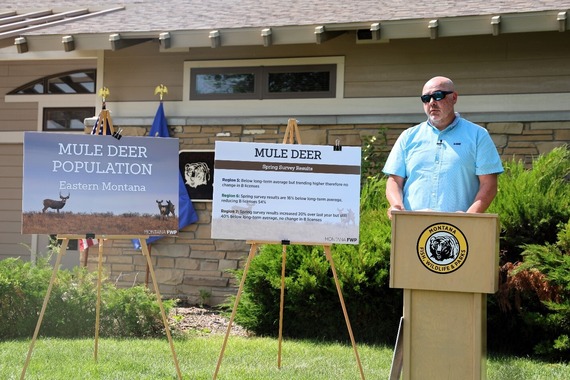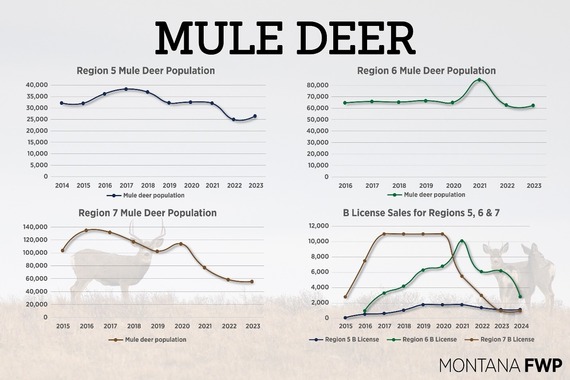FWP director addresses state of mule deer in eastern Montana
Tuesday Jun. 25th, 2024
BILLINGS – Monday, alongside Wildlife Manager Brett Dorak, Montana Fish, Wildlife & Parks Director Dustin Temple held a press conference to address the status of eastern Montana’s mule deer.
“Our job at FWP is to manage Montana’s wildlife resources by providing full contextual, transparent, accurate data with full context,” Director Temple said. “Across the state, we are making the effort to ensure our management of mule deer is based on the best science and data.”

FWP Director Dustin Temple discusses eastern Montana mule deer numbers at a Monday press conference in Billings.
FWP biologists have completed annual spring surveys. For Region 5, the numbers are below the long-term average but are trending higher. Quotas for B licenses are already at the low end of the approved quota, so there is no change. As for Region 6, where spring survey results are 16 percent below long-term average, FWP is reducing B licenses by 54 percent. Lastly, Region 7 spring survey results show an increase of 20 percent over the last year, but total numbers are still 40 percent below long-term average. Just like Region 5, B licenses are already at the minimum of the approved quota range, so there is no B license change.
“Improved weather and habitat conditions across eastern Montana had led to increased fawn ratios observed this spring in eastern Montana and some increases in total mule deer observed, as well,” FWP Region 7 Wildlife Manager Brett Dorak said. “Currently though, most mule deer populations are below their long-term average.”

FWP Wildlife Manager Brett Dorak discusses trends in mule deer numbers across regions in eastern Montana at a press conference Monday in Billings.
A few other major changes to this year’s hunting season regarding mule deer are:
- Antlerless mule deer in Regions 6 and 7 can only be harvested on private property this coming fall, which is a change from years past.
- Beginning in the 2024 hunting season, only antlered buck mule deer may be harvested with a General Deer License in all Region 5 hunting districts. In six of the 10 Region 5 deer and elk hunting districts, youth hunters aged 10-15 may harvest either sex mule deer with a General Deer License.
- Nonresidents may only purchase one Deer B License unless they drew a combo, which allows them to purchase two total. Before this year, nonresident hunters could purchase up to seven Deer B Licenses.
Decade snapshot of Montana mule deer population

These graphs show mule deer populations trends along with Mule Deer B License sale trends for the same regions.
Mule deer populations across eastern Montana are somewhat variable in their trends. The three main drivers for mule deer populations are weather, habitat and disease. Mule deer populations across eastern Montana have decreased mainly due to unfavorable weather patterns with multiple years of extreme drought conditions and some hard winter. Drought conditions have had major impacts on habitat for mule deer. In response to mule deer population decreases, FWP has decreased B licenses in eastern Montana and in some cases to historically low quota numbers. More specifically, Region 7 has decreased B licenses by 91 percent over the past couple years, and Region 6 had recently decreased their B licenses by 54 percent in response to mule deer numbers.
The reason behind our work
Alexis Turner, a 13-year-old Billings middle schooler, also joined the director at the podium to share her own Montana mule deer experience. As an avid hunter, Alexis has been hunting since she was 10. Her first mule deer was a beautiful five-point buck. With excitement in her voice, she perfectly represented the purpose behind FWP’s work.
“After a 320-yard shot, I shot my first mule deer in the heart,” Alexis said. “Although it was a lot of work to get to the deer, it was a lot more work to get back to the truck. My heart was pounding, and I was very excited I made the shot.”
“This photo of Alexis and her first mule deer harvest is a perfect picture of how much our work means to the state of Montana,” Temple said. “We have a responsibility to do everything in our power to provide opportunities for memories like these.”
| Tweet |